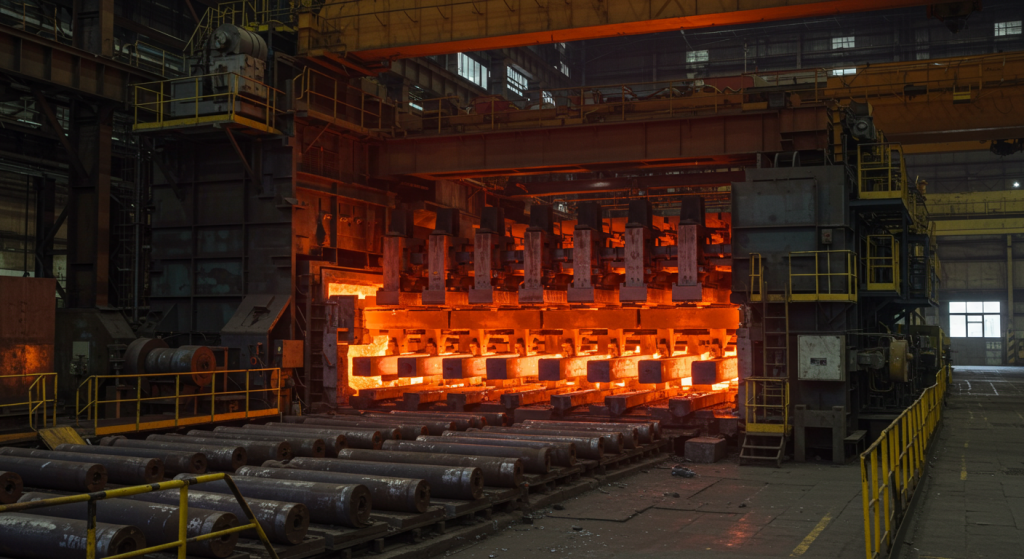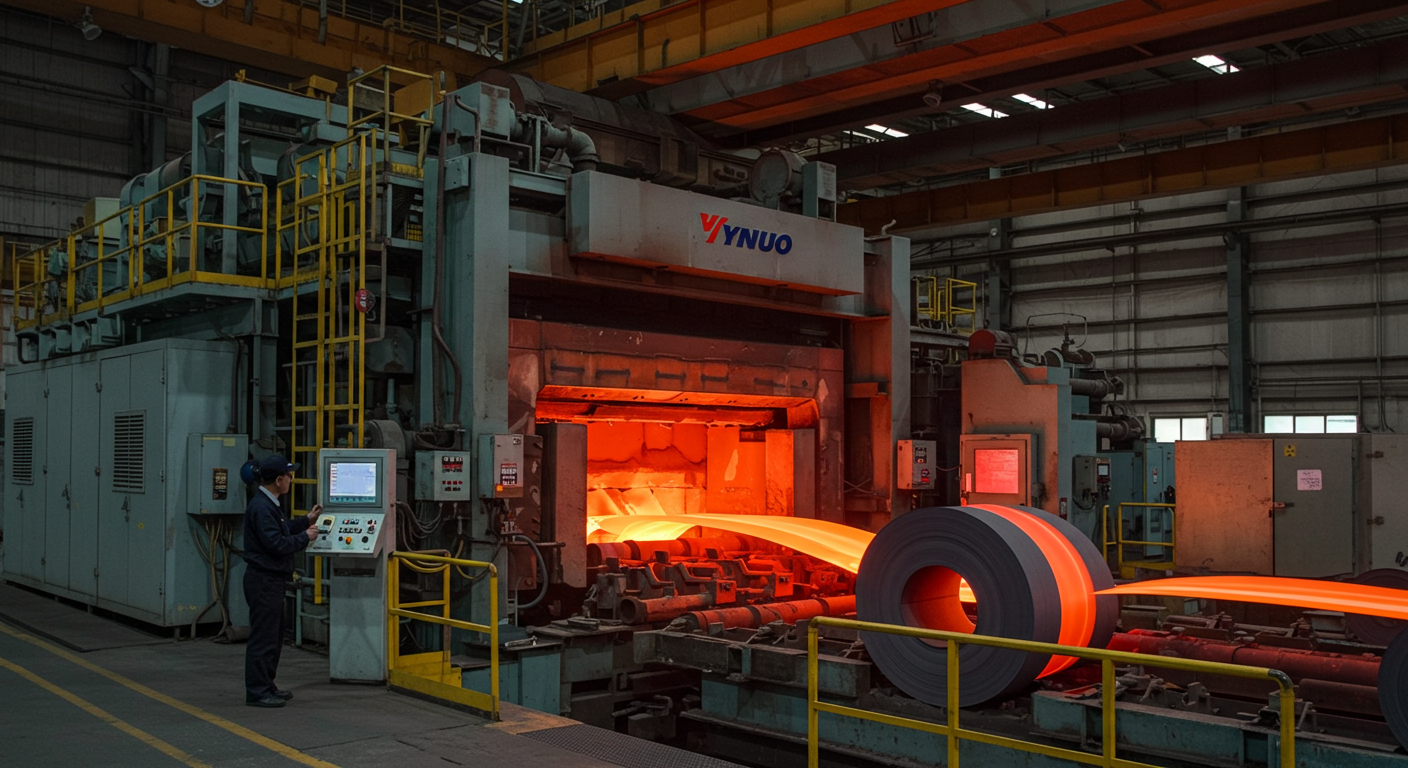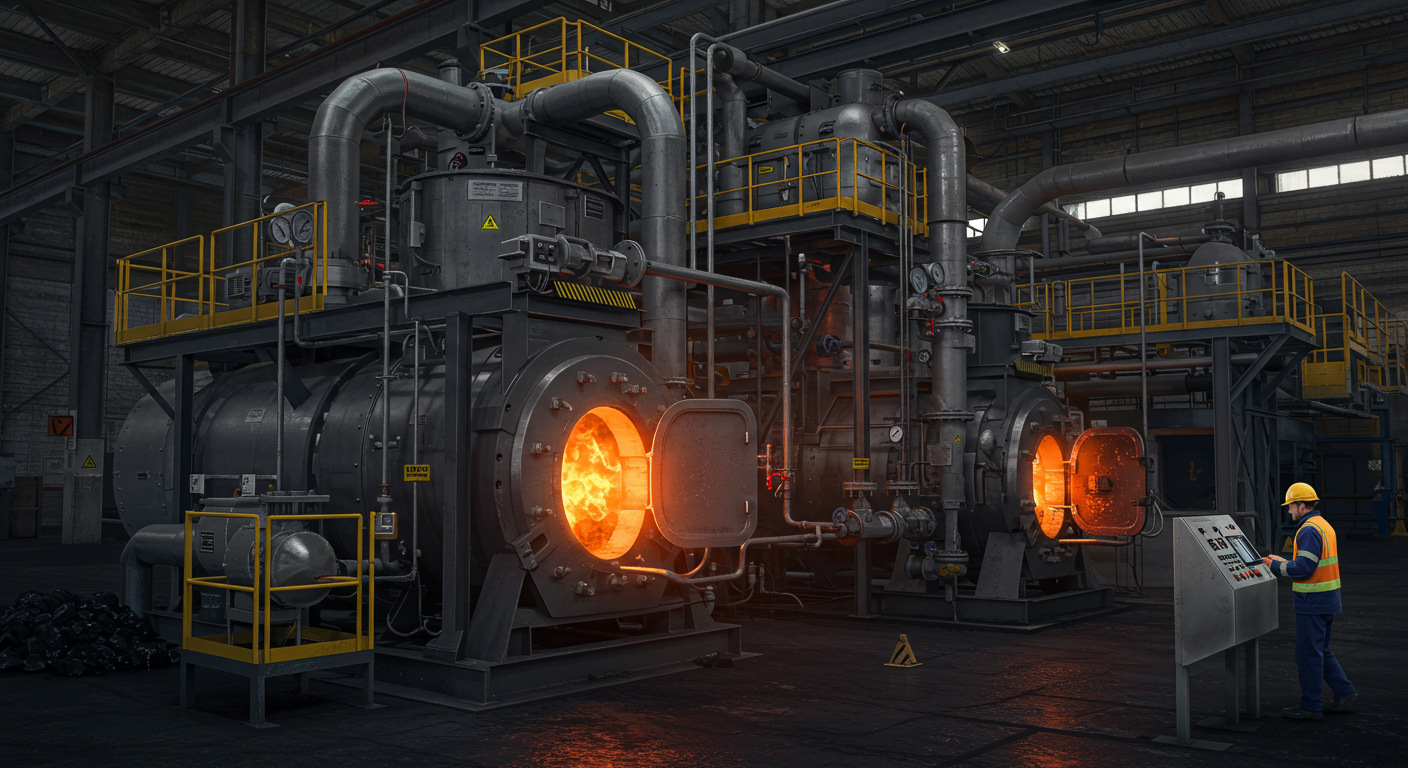
Walking beam type reheating furnaces are advanced continuous systems engineered to preheat steel billets, blooms, slabs, or bars for hot rolling, forging, or extrusion, utilizing a sophisticated walking beam mechanism to transport materials through thermal zones. This mechanism ensures precise positioning and uniform heating, making these furnaces essential for industries like steel production, automotive, and infrastructure. Jiangsu Yinuo Thermal Energy Technology Co., Ltd., based in Xuzhou, China, stands as a global leader in manufacturing cutting-edge walking beam type reheating furnace solutions. This guide explores the technology, applications, and benefits of these furnaces, detailing their role in modern industrial steel processing with a focus on precision, efficiency, and sustainability.
Understanding Walking Beam Type Reheating Furnace Technology
Walking beam type reheating furnaces heat steel to temperatures typically between 1100°C and 1250°C, preparing it for deformation in rolling mills or forging presses. The walking beam mechanism, a hallmark feature, employs a series of fixed and movable beams to lift, advance, and lower steel workpieces, ensuring smooth, controlled movement without surface damage. Integrated with advanced heating systems and automation, these furnaces deliver uniform temperature distribution and high throughput, ideal for processing heavy or large steel loads in continuous production environments.
Core Components
The furnace structure includes a heating chamber constructed with refractory materials, such as high-alumina bricks or ceramic fiber insulation, to withstand temperatures up to 1300°C. Gas-fired regenerative burners or radiant tube burners provide efficient heat, with electric heating elements as cleaner alternatives for specific applications. The walking beam mechanism consists of fixed beams, anchored to the furnace floor, and movable beams, driven by hydraulic or electromechanical actuators, supported by water-cooled or refractory-coated skids. Temperature control systems, utilizing PID controllers or PLC-based automation, regulate multi-zone heating. Atmosphere control systems, employing nitrogen or hydrogen blends, prevent oxidation, while entry and exit skids facilitate material handling.
Operational Mechanism
Steel billets or slabs are loaded onto entry skids outside the furnace. The walking beam mechanism initiates a cyclic motion: movable beams, synchronized by actuators, lift the steel off fixed beams, advance it forward (typically 0.5–2 meters per cycle), and lower it back onto the fixed beams, progressing through preheating, heating, and soaking zones. The preheating zone gradually raises temperatures to 600–800°C, minimizing thermal shock. The heating zone elevates steel to 1100–1250°C, ensuring ductility for rolling or forging. The soaking zone maintains uniform heat penetration, critical for thick slabs. The steel exits via discharge skids for downstream processing. Automated controls ensure precise beam movement, temperature profiles, and atmosphere conditions, optimizing efficiency and quality.
Key Applications of Walking Beam Type Reheating Furnaces
Walking beam type reheating furnaces serve a wide range of industries, enabling precise reheating for steel products requiring specific mechanical properties. Their ability to handle heavy, large-scale workpieces makes them ideal for continuous, high-volume production environments.
Steel Production for Construction
In steel production, walking beam type reheating furnaces preheat billets or slabs for hot rolling into rebar, structural beams, or plates used in construction. The mechanism’s precise movement ensures uniform heating, enhancing microstructure consistency for strength and ductility. These furnaces support rolling mills producing high volumes of steel for buildings, bridges, and highways, meeting rigorous infrastructure demands.
Automotive Sheet and Component Production
Automotive applications involve preheating steel slabs for rolling into sheets or forging components like axles, chassis parts, or suspension systems. The walking beam mechanism prevents surface damage, ensuring high-quality sheets for vehicle body panels. Multi-zone heating supports processing high-strength steels, aligning with the automotive industry’s focus on lightweight, durable materials for fuel efficiency and safety.
Heavy Industry and Shipbuilding
Heavy industry relies on these furnaces to preheat thick slabs for rolling into plates for ships, pipelines, and industrial machinery. The mechanism’s capacity to handle loads up to 300 tons ensures robust processing, while protective atmospheres maintain surface quality for corrosion-resistant plates, essential for marine and industrial applications.
Specialty Steel and Alloy Processing
For specialty applications, walking beam type reheating furnaces heat stainless or alloy steels for rolling into high-performance products, such as aerospace components or chemical plant equipment. The mechanism’s gentle handling minimizes distortion, while precise temperature control ensures tailored material properties, meeting stringent industry standards.
Benefits of Walking Beam Type Reheating Furnaces
Walking beam type reheating furnaces offer distinct advantages, addressing the needs of industries prioritizing precision, efficiency, and environmental responsibility. Their advanced design delivers performance tailored to demanding steel processing applications.
Precise Material Handling
The walking beam mechanism lifts and advances steel without sliding, preventing surface scratches or damage, as noted in industry practices. This ensures high-quality surfaces, critical for automotive sheets or specialty steels, and supports processing of heavy or long workpieces (up to 12 meters) with minimal deformation risk.
Uniform Heating
Multi-zone temperature control, combined with regenerative burners, achieves uniform heating across large steel loads, eliminating hot spots and thermal gradients. Atmosphere management systems maintain protective gases, reducing scaling, which enhances the mechanical properties of rolled or forged steel products.
High Throughput and Efficiency
Continuous operation supports high-throughput production, with furnaces capable of processing up to 500 tons per hour, depending on size. The mechanism’s cyclic motion optimizes material flow, reducing cycle times compared to batch systems, ideal for large-scale rolling mills.
Energy Efficiency
Regenerative burners recover up to 85–90% of waste heat, reducing fuel consumption by 30–50%. Ceramic fiber insulation minimizes heat loss, lowering energy costs. These features reduce carbon emissions, aligning with environmental sustainability goals, as emphasized in modern furnace designs.
Technical Advantages of Walking Beam Type Reheating Furnaces
Walking beam type reheating furnaces incorporate advanced features that optimize performance, material quality, and operational reliability, addressing the challenges of industrial steel reheating.
Robust Walking Beam System
The walking beam system uses heat-resistant alloy beams, often water-cooled or refractory-coated, to withstand temperatures up to 1300°C and support loads exceeding 300 tons. Hydraulic or electromechanical actuators ensure precise, synchronized movement, with adjustable beam strokes (e.g., 200–500 mm) for different material sizes, enhancing flexibility and durability, as highlighted in industry sources.
Advanced Heating Systems
Regenerative burners cycle between firing and exhaust, preheating combustion air to 1000–1200°C, reducing fuel use by up to 50%. Low-NOx designs minimize emissions, complying with regulations. Radiant tube burners provide indirect heating for sensitive steels, ensuring clean surfaces, critical for high-quality rolling.
Precision Automation
PLC-based control systems with IoT integration enable real-time monitoring of temperature, beam movement, and atmosphere conditions. Automated material tracking and cycle optimization reduce human intervention, while predictive maintenance algorithms minimize downtime, ensuring reliable operation in high-volume environments.
Atmosphere Management
Protective atmospheres, such as nitrogen-hydrogen blends, prevent oxidation and scaling, critical for stainless or alloy steels. Gas-tight casings and automated atmosphere monitoring maintain precise gas compositions, ensuring consistent surface quality, as required in automotive and aerospace applications.
Industry-Specific Considerations
Different industries require tailored walking beam type reheating furnace configurations to meet specific process and material demands, ensuring optimal performance and cost efficiency.
Steel and Construction
Construction applications prioritize high-capacity furnaces for large slabs or billets, requiring temperatures up to 1250°C for rolling rebar or beams. Gas-fired regenerative burners reduce costs, while heavy-duty walking beams handle loads up to 300 tons, supporting infrastructure projects.
Automotive and High-Strength Steels
Automotive applications demand precision for rolling high-strength steel sheets. Furnaces with tight temperature tolerances (±5°C) and nitrogen atmospheres ensure surface quality. Rapid beam cycles support high-volume production, critical for lightweight vehicle components.
Heavy Industry and Shipbuilding
Heavy industry requires furnaces for thick slabs, rolled into plates for ships or pipelines. Walking beam systems with robust actuators manage heavy loads, while protective atmospheres maintain corrosion-resistant surfaces, essential for marine applications.
Aerospace and Specialty Steels
Aerospace applications involve reheating stainless or alloy steels for precision rolling. Hydrogen atmospheres and precise thermal cycles prevent oxidation, while gentle beam handling minimizes distortion, meeting standards like AMS 2750 for critical components.
Challenges and Solutions
Walking beam type reheating furnaces face challenges like energy consumption, surface quality control, and mechanical wear, but advanced engineering addresses these issues effectively.
Energy Consumption
High-temperature reheating consumes significant energy. Regenerative burners and ceramic fiber insulation reduce losses by up to 50%, while electric heating options enhance efficiency for smaller furnaces, as noted in industry practices.
Surface Quality Control
Scaling or surface damage can occur during reheating. Protective atmospheres and radiant tube heating ensure clean surfaces, while the walking beam’s non-sliding motion prevents scratches, critical for high-quality steel products.
Mechanical Wear and Maintenance
Heavy loads and high temperatures stress beam components. Water-cooled or refractory-coated beams extend lifespan, while IoT-enabled diagnostics and spare parts bundling reduce downtime, ensuring continuous operation, as recommended in industry sources.
Future Trends in Walking Beam Type Reheating Furnaces
The walking beam furnace industry is evolving, driven by advancements in automation, sustainability, and material processing, shaping the future of industrial steel reheating.
Automation and Smart Technology
AI-driven controls and IoT integration enable real-time optimization, predictive maintenance, and material tracking. Automated beam cycles and thermal profiling reduce labor costs and enhance precision, supporting high-volume production with complex steel grades.
Sustainability Initiatives
Electric furnaces and renewable energy integration lower carbon emissions, aligning with environmental regulations. Ultra-low NOx regenerative burners and advanced insulation further reduce environmental impact, supporting sustainable steel processing.
Advanced Material Processing
Demand for furnaces supporting high-strength steels and specialty alloys is rising. Walking beam furnaces are adapting to process materials like 22MnB5 steel for hot forming, requiring precise thermal cycles, supporting innovation in automotive and aerospace applications.
Choosing a Walking Beam Type Reheating Furnace
Selecting a walking beam type reheating furnace requires evaluating process, material, and production needs to ensure optimal performance and cost efficiency.
Key Considerations
Material type, such as carbon or stainless steel, determines furnace configuration and atmosphere requirements. Process needs—hot rolling or forging—dictate temperature range and beam capacity. Production scale influences furnace size, with high-throughput mills needing wider designs. Energy efficiency, driven by regenerative burners, impacts costs. Automation and maintenance support ensure reliability.
Partnering with Jiangsu Yinuo
Jiangsu Yinuo’s team provides expert guidance, designing custom furnaces tailored to industrial goals. Installation and ongoing support ensure seamless performance, delivering precision and efficiency. Clients can explore solutions and connect through the Jiangsu Yinuo website for tailored furnace options, backed by global expertise.
FAQ
What is the purpose of a walking beam type reheating furnace?
Walking beam type reheating furnaces preheat steel for hot rolling or forging, ensuring precise movement and uniform heating for industrial applications.
What steel types can walking beam furnaces process?
Carbon steel, alloy steel, stainless steel, and specialty steels are processed, supporting construction, automotive, and aerospace industries.
How is furnace quality ensured?
Production involves rigorous testing of components, using premium refractories, with compliance documentation meeting ISO and CE standards.
Are walking beam furnaces customizable?
Furnaces are tailored to specific material, process, and production needs, with support from design to installation.
How energy-efficient are walking beam furnaces?
Regenerative burners and insulation reduce fuel use by up to 50%, lowering costs and emissions.
How can a quote be requested from Jiangsu Yinuo?
A contact form, email, or phone inquiry through the Jiangsu Yinuo website provides a prompt response.
Conclusion
Walking beam type reheating furnaces deliver precision, efficiency, and sustainability, driving high-quality steel production in construction, automotive, and heavy industry. Jiangsu Yinuo Thermal Energy Technology Co., Ltd. offers innovative, customized solutions that empower manufacturers globally. With advanced technology and a focus on performance, these furnaces meet the demands of modern steel processing. Explore solutions and connect through the website for a tailored quote to enhance production capabilities today.







